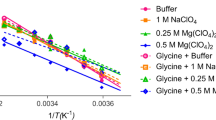Abstract
Different heat inactivation rates were found among the three common homozygous human placental alkaline phosphatase phenotypes with respect to component I (the rapidly migrating component). Phenotype I1 was less stable than F1 and S1, while types F1 and S1 exhibited very similar thermostabilities, F1 being slightly more stable than S1. Components I, IIα (the fastest of the slow-moving components), and IIβ (the group of the very slowly migrating components) had different heat stabilities, IIβ being the most stable and I the least stable. Magnesium greatly increased the heat stability of all tested phenotypes. Placental alkaline phosphatase was found to be less heat resistant than reported previously. All phenotypes were equally inhibited over urea concentrations ranging from 0.5 to 8 m. No difference in the inhibition rate was found among components I, IIα, IIβ, and the crude placental butanol extract. The altered electrophoretic pattern of the crude placental extract obtained by urea starch gel electrophoresis was considered as being most likely due to reversible changes in the folding of the molecules.
Similar content being viewed by others
References
Bahr, M., and Wilkinson, J. H. (1967). Urea as a selective inhibitor of human tissue alkaline phosphatases. Clin. Chim. Acta 17 367.
Beckman, G. (1970). Placental alkaline phosphatase, relation between phenotype and enzyme activity. Human Hered. 20 74.
Beratis, N. G., Seegers, W., and Hirschhorn, K. (1970). Properties of placental alkaline phosphatase. I. Molecular size and electrical charge of the various electrophoretic components of the six common phenotypes. Biochem. Genet. 4 689.
Beratis, N. G., Seegers, W., and Hirschhorn, K. (1971). Properties of placental alkaline phosphatase. II. Interactions of fast- and slow-migrating components. Biochem. Genet. 5 367.
Birkett, D. J., Conyers, R. A. J., Neale, F. C., Posen, S., and Brudenell-Woods, J. (1967). Action of urea on human alkaline phosphatases: With a description of some automated techniques for the study of enzyme kinetics. Arch. Biochem. Biophys. 121 470.
Boyer, S. H. (1961). Alkaline phosphatase in human sera and placentae. Science 134 1002.
Boyer, S. H. (1963). Human organ alkaline phosphatases: Discrimination by several means including starch gel electrophoresis of antienzyme-enzyme supernatant fluids. Ann. N. Y. Acad. Sci. 103 938.
Butterworth, P. J., and Moss, D. W. (1966). The effect of urea on human kidney alkaline phosphatase. Biochem. J. 99: 9P.
Fishman, W. H., Inglis, N. R., Green, S., Anstiss, C. L., Gosh, N. K., Reif, A. E., Rustigian, R., Krant, M. J., and Stolbach, L. L. (1968). Immunology and biochemistry of Regan isoenzyme of alkaline phosphatase in human cancer. Nature 219 697.
Morgenstern, S., Kessler, G., Auerbach, J., Flor, R., and Klein, B. (1965). An automated p-nitrophenylphosphate procedure for the AutoAnalyzer. Clin. Chem. 11 876.
Morton, R. K. (1954). The purification of alkaline phosphatases of animal tissues. Biochem. J. 57 595.
Neale, F. C., Clubb, J. S., Hotchkis, D., and Posen, S. (1965). Heat stability of human placental alkaline phosphatase. J. Clin. Pathol. 18 359.
Poulik, M. D. (1957). Starch gel electrophoresis in a discontinuous system of buffers. Nature 180 1477.
Poulik, M. D. (1963). Electrophoretic map of chemically derived sub-units of papain-digested γ-globulin. Nature 198 752.
Poulik, M. D. (1964). Starch gel immunoelectrophoresis. Ann. N. Y. Acad. Sci. 121 470.
Robson, E. B., and Harris, H. (1965). Genetics of the alkaline phosphatase polymorphism of the human placenta. Nature 207 1257.
Robson, E. B., and Harris, H. (1967). Further studies on the genetics of placental alkaline phosphatase. Ann. Human Genet. 30 219.
Smithies, O, Connell, G. E., and Dixon, G. H. (1962). Inheritance of haptoglobin subtypes. Am. J. Human Genet. 14 14.
Author information
Authors and Affiliations
Additional information
This work was supported in part by U.S. Public Health Service Grant HDO2552.
Rights and permissions
About this article
Cite this article
Beratis, N.G., Hirschhorn, K. Properties of placental alkaline phosphatase. III. Thermostability and urea inhibition of isolated components of the three common phenotypes. Biochem Genet 6, 1–8 (1972). https://doi.org/10.1007/BF00485959
Received:
Revised:
Issue Date:
DOI: https://doi.org/10.1007/BF00485959




